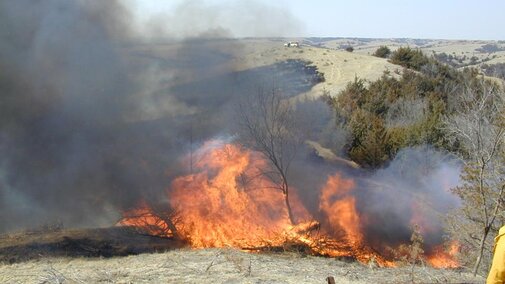Prescribed Burning
Spring is a key time when prescribed burning of pasture and CRP lands occurs. Within this time period, there are a limited number of days when weather conditions such as wind speed, direction and humidity meet the required prescription for the unit that is being burned. With this, having a detailed burn plan is needed to make sure the work is done safely. One should also consider the very dry conditions this year and the possibility of a continuing drought.
The primary objective of most prescribed burns in Nebraska is to control eastern red cedar trees. However, prescribed burns can also improve grass stands, prepare them for interseeding, reduce annual grassy and broadleaf weeds, enhance wildlife habitat and improve forage quality.
Safe and controlled prescribed burns don’t just happen. It takes preparation, planning and an understanding of how fire reacts in certain weather conditions, with particular fuel loads and on various types of topography. Many times, the preparation will begin a year in advance.
Plan your prescribed burn carefully and be aware of the topography and other factors that will affect how the fire behaves. Never burn unless weather conditions are within your burn prescription. Plus, make sure your burn is legal. You must obtain a burn permit from your local fire chief. And finally, it is always a great benefit to have experienced people leading and being part of the prescribed burning crew.
Grass Tetany
Fresh spring growth is a welcome sight for producers looking for animal forage. However, lush spring growth may be the perfect condition for a case of grass tetany. While turnout may be a ways off, mitigating this risk starts now.
Grass tetany is the result of low levels of magnesium in an animal’s blood stream. Low magnesium levels in lush, newly growing grass are often a main cause. In lactating animals, low dietary magnesium paired with a drain on calcium from milk production increases risk even more. Calcium aids in magnesium absorption. This means high milk-producing and older animals are most at risk for developing tetany.
To prevent tetany problems this spring, it’s best to wait until grass in pastures has grown to at least six inches high before grazing. Legumes like alfalfa or clover are a good source of magnesium, so grazing mixed grass and legume pastures can help balance mineral demands.
While cultural practices can reduce risk, providing correct and adequate mineral supplementation may be the most certain remedy. Cattle should be consuming 3-4 ounces daily of mineral containing supplemental calcium and 10-13% magnesium oxide. This should start at least 30 days before grazing begins to ensure proper intake has been established.
Most high magnesium minerals utilize magnesium oxide, which is bitter tasting and can reduce animal consumption. Mix magnesium fortified mineral with salt into a complete package or feed with a highly palatable protein or energy supplement to improve intake.
High magnesium mineral should be provided for animals until cool-season grasses slow down growth and the levels of lush, fresh forage are reduced — around mid-May.
Dealing with grass tetany in the spring doesn’t have to negatively impact your herd. Plan now to adjust grazing management or mineral supplementation for a tetany-free spring.
Controlling Winter Annual Weeds
By Brad Schick
When even a little moisture is available, weeds in our alfalfa fields take off. Before our alfalfa greens up and breaks being in a dormant state, try and eliminate those weeds. The weeds that really seem to get ahead of us in the spring are winter annuals — pennycress, downy brome, mustards, cheatgrass and shepherd’s purse. They often can make up a significant portion of our first cutting of alfalfa and reduce the quality and palatability of that hay. Excessive weeds will also increase dry-down time, lengthening harvest time and increasing the chance for precipitation on cut hay.
Before applying any herbicide, check to make sure these weeds are actually causing economic damage to the alfalfa. A field that looks full of weeds from the road may not actually be as bad as you may think.
If you walk into an alfalfa field today, most anything growing will be unwanted plants that may need to be sprayed. However, alfalfa shoots that have started to grow and are green may be set back several weeks if they are sprayed incorrectly. Depending on your herbicide, spray before the alfalfa shoots green up or meet the alfalfa height recommendations.
If alfalfa is growing, fields needing control may need herbicide options that can be applied to new alfalfa growth. Some of the herbicides that can be used include Velpar, Karmex, Sinbar/Pursuit, and Raptor. EC 130, Guide for Weed, Disease, and Insect Management in Nebraska (Weed Guide) may provide some additional options. When selecting herbicides, make sure they are effective on the weed species you seek to control.
Winter annuals can quickly take over portions of a hay field and once that happens, more labor-intensive, drastic measures will have to be taken in order to reclaim the alfalfa potential. Know the purpose of your alfalfa. If quality is not needed, herbicides may not be needed either.
In any case, timing is essential. Control winter annuals before alfalfa comes out of dormancy and before they become a problem.

